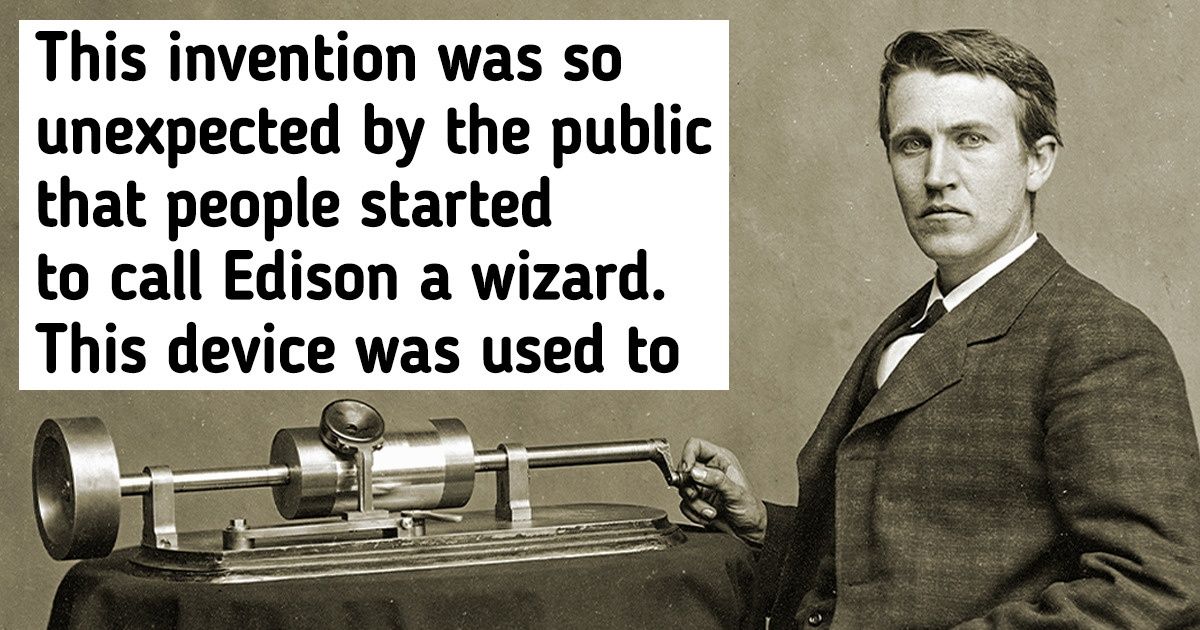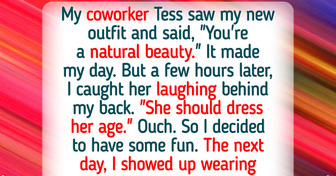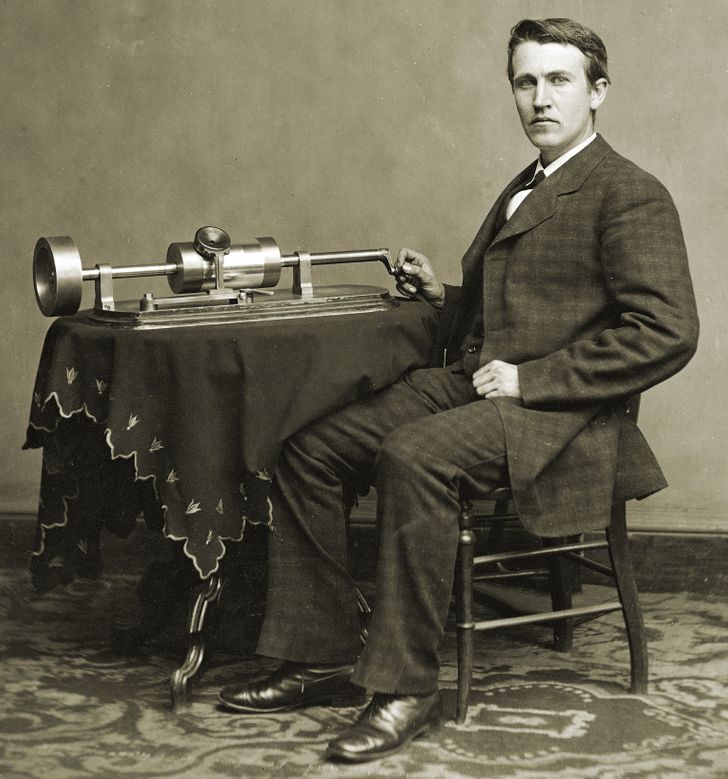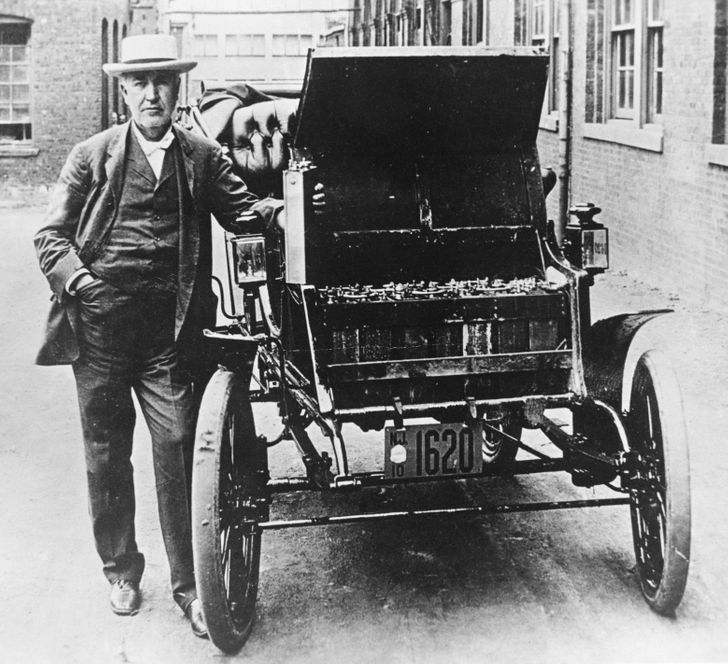hehe
6 Game-Changing Inventions by Thomas Edison That Made People Call Him a Wizard

Thomas Edison was way ahead of his time with his ingenious creations. Some of his works were his own inventions, while others seriously improved the devices developed by other researchers. From batteries for electric cars to a mysterious “spirit phone,” each of Edison’s devices stirred the public’s imagination and brought science and technology one big step closer to progress. No matter what Thomas Edison created, he always tried to solve practical problems and make our lives more comfortable and enjoyable.
Here at Bright Side, we can’t stop admiring Thomas Edison’s creative thinking, and we want to tell you more about 6 of his ingenious inventions.
1. The phonograph that recorded sounds on tinfoil
Thomas Edison with his phonograph
In 1876, Edison built a research laboratory in Menlo Park, New Jersey. A year later, in 1877, he invented something that was so unexpected that it made people call him “The Wizard of Menlo Park” and it made Edison a real celebrity. This invention was the phonograph that was meant to record sounds on tinfoil around a cylinder, as shown in the picture above.
Even though the quality of the sounds recorded by the phonograph was rather poor and you could listen to these recordings only a few times, this device was a real sensation back in those days and helped Edison strengthen his reputation as a genius inventor.
2. The “spirit phone” that could let the living talk to those who’ve left this earth
The personality of Thomas Edison had enough room for both faith and science, and the so-called “spirit phone” he worked on can illustrate it better than any words. The inventor believed that living beings are made of “myriads and myriads of infinitesimally small individuals, each in itself a unit of life,” and that these small units were eternal and they “kept” the personality of the person after death.
The spirit phone never saw the light of day, but if it did, in Edison’s imagination this machine would find the personalities of the diseased people in their new environment and help them exchange messages with the world of the alive.
“If the apparatus I am now constructing should provide a channel for the inflow of knowledge from the unknown world—a form of existence different from that of this life—we may be brought an important step nearer the fountainhead of all knowledge, nearer the intelligence which directs it all,” Edison believed.
3. The improved light bulb and electric light system
Thomas Edison holding a light bulb
Edison started his work on finding ways to get electrical illumination in 1878. Even though Edison did not invent the light bulb, he tried to improve the existing models and make their light last longer. In 1879, he filed for a patent for an electric lamp that used “a carbon filament or strip coiled and connected to platina contact wires.”
In 1878, Edison organized the Edison Electric Light Company in New York City. After experimenting with different kinds of materials for his light bulb, Edison finally chose bamboo which made the light bulb more durable. The inventor was determined to make electricity available and cheap, and he said: “We will make electricity so cheap that only the rich will burn candles.” Edison’s light bulb was first commercially used to lighten the steamship Columbia that belonged to the Oregon Railroad and Navigation Company.
4. The automatic telegraph that improved the previous telegraph version
The first version of the telegraph that was developed in the 1830s and 1840s by Samuel Morse and other inventors, created a revolution because it allowed people to exchange information through long distances. With the original telegraph, the operator listened to the messages in Morse code and translated the message.
Thomas Edison improved the telegraph by introducing a chemical recording system, and this device could record up to 1,000 words per minute, which considerably increased the speed of the original telegraph version that could record 25-40 words per minute.
5. A Kinetograph and a Kinetoscope that allowed the recording and showing of motion pictures
A Kinetograph camera
Another revolutionary device invented by Edison’s company was a motion picture camera called a Kinetograph. Edison worked on this camera together with William Kennedy Dickson, who got almost all the credit for this invention. In 1891, Edison built a peep-hole viewer called a Kinetoscope, which allowed people watch short films (and must have looked like magic for the audience of those days), and soon this device conquered Europe.
Edison’s film studio produced nearly 1,200 films, the majority of which were short films that showed acrobats, firefighting scenarios, and other different life situations. Some of the titles produced by Edison’s studio include The Kiss (1896), The Great Train Robbery (1903), Alice’s Adventures in Wonderland (1910), and the first Frankenstein film from 1910.
6. Rechargeable batteries that were used in electric cars
Thomas Edison with an electric car
The end of the 19th century was an era when electric cars were popular, and back in the 1890s Edison was working hard to improve existing rechargeable batteries to make them lighter and more efficient. In 1901 Edison patented his nickel-iron battery and opened the Edison Storage Battery Company that manufactured batteries for electric cars. Edison did not stop there and he kept improving the battery until in 1910, when he introduced a highly efficient and durable nickel-iron battery to the market that used lye as an electrolyte.
When internal combustion engines and cheap petrol took the stage, electric cars started to lose their popularity, but this and other inventions by Thomas Edison were a great contribution to the progress of science and technology. This great thinker and inventor embodied the ideal of applied research — making what’s really necessary and fulfilling the needs of humanity.
Was there anything new about Thomas Edison that you learned after reading our article? What of Edison’s other inventions seriously improved our lives, in your opinion?
Comments
He was so influential revolutionising electricity, one of the biggest electric car manufacturers is named Tesla not Edison. The article forgot to mention how he treated people and how he electrocuted an elephant just to scare people into using his system. Whats next, PT Barnum, Americas nicest guy?
Nikola Tesla
he lucija k we talked over the summer remember me!?
Thanks for saying that he improved the light bulb rather then invented it... kinda triggers me when people get it wrong ?
Related Reads
13 Non-Obvious Things That Can Influence the Outcome of Your Job Interview

I Refuse to Be My Sister’s Free Full-Time Nanny—I Don’t Like Kids, and I’m Proudly Child-Free

12 Moments That Show Kindness Isn’t Weak—It’s Power in Disguise

13 Times People Accidentally Uncovered Someone’s Biggest Secret

10 People Who Still Chose Kindness Even When Life Tested Them

10 Stories That Prove Kindness Is More Powerful Than People Think

18 Employees Who Saw Their Choices Backfire Hard

I Refused to Give My Childfree Daughter Her Inheritance, Then She Showed Up With a Surprise

I Refused to Let Mom Move In With Me—My Privacy Isn’t Up for Debate

I Refused to Chip In for Our “Mandatory” Work Party—HR Stepped In Fast

My MIL Refused to Believe in My Son’s Gluten Allergy

I Refused to Leave My Legacy to My Adopted Grandkid—He’s Not My Real Family



